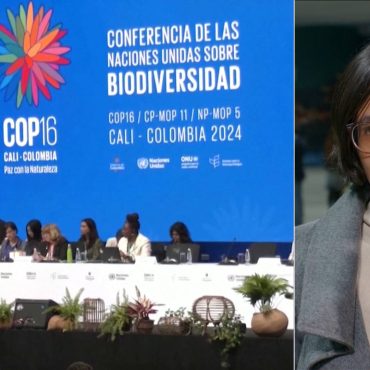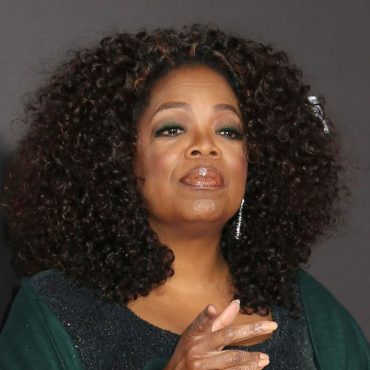This is a rush transcript. Copy may not be in its final form.
AMY GOODMAN: This is Democracy Now!, democracynow.org, “War, Peace and the Presidency: Breaking with Convention.” I’m Amy Goodman, with Nermeen Shaikh.
NERMEEN SHAIKH: We’re continuing to look at Donald Trump’s running mate, Ohio Senator J.D. Vance, who first gained fame after he wrote his memoir, Hillbilly Elegy.
We’re joined by Nancy Isenberg. She’s an American historian and the author of the award-winning book, White Trash: The 400-Year Untold History of Class in America.
AMY GOODMAN: She wrote a widely cited review of Hillbilly Elegy for The New York Review of Books in 2018 headlined “Left Behind.” She is professor emeritus of history at Louisiana State University.
Welcome to Democracy Now! It’s great to have you with us, Nancy Isenberg. When President Trump named J.D. Vance as the vice-presidential nominee, as his pick to be vice president if he wins, can you talk about your response, informed by your response to Hillbilly Elegy?
NANCY ISENBERG: Yeah. Hi. I wasn’t completely surprised, because I did write a review that I think didn’t go along with the general chatting class consensus that this — that Hillbilly Elegy was somehow a revelation or told us the truth about the people who were supporting Trump. I’m more skeptical. I was skeptical from the beginning, because memoirs are about self-fashioning.
The strongest message in Hillbilly Elegy, which is the one that was echoed last night at the Republican convention, is the self-made man myth. This is the myth that somehow America creates opportunities, and just like Benjamin Franklin, you can fashion yourself, and you can rise the ladder to success. And this is very much something that J.D. Vance, I think, believes in. It is a part of his memoir.
But much of what his memoir says tells us nothing about real class conditions. I mean, the person you just had on from Politico, who talked about the Scots-Irish tradition, that’s a myth. That was a myth that was reinvented in the 1980s by people like Grady [McWhiney], who were trying to shift the debate to an ethnic identity instead of talking about class. And that is something that Americans have trouble addressing, is class divisions. And the Republicans don’t talk about them, and the Democrats don’t talk about them. And I think this is kind of the undercurrent of J.D. Vance.
And I would say, on top of everything, the reason he was chosen — and what wasn’t mentioned so far — is because of his youth. This has been in the news, the media. Everyone has been attacking Biden for being too old, and then Trump is too old. So now they pick a 39-year-old young man who projects youthfulness. Why? Because it appeals to the media. That’s why he’s on the ticket, and that he had — his rise was created by the mainstream media. It was the liberals who embraced him. It was the liberals who were reading Hillbilly Elegy, not Trumpsters.
NERMEEN SHAIKH: And so, Professor Nancy Isenberg, if you could, you know, explain the argument in your book, White trash: The 400-Year Untold History of Class in America — first of all, explain the origin of this extraordinary phrase, “white trash,” and then what the myths are about class and poverty that pervade American political and social life, and why you think that’s the case.
NANCY ISENBERG: Well, my book is challenging the big myth about America, which, again, is the American dream, which is connected to the self-made man, that somehow, magically, at the time of the Revolution, we broke from Great Britain and we eliminated aristocracies, we eliminated class divisions, and somehow we were a unique, free, liberated people. Well, none of that is true. We have, throughout our history, relied heavily on English traditions. Where you think we got our law? The common law. And not only that, the ideologies of class have been pervasive in America.
And I think this is the sad thing that we forget, and the reason that “white trash” still exists today, is because it goes all the way back to the colonial period. It goes back to the Elizabethan period, when the original purpose on the part of the English for colonization was to dump the, quote, “waste people.” That’s where “white trash” comes from, referring to the expendables, the people who were hurting the economy in Great Britain. Dump them into the colonies, and get rid of the rubbish. That’s the term that Thomas Jefferson used. He referred to “raked from the rubbish.” So, “trash” literally means trash. And if you can think of any negative connotation associated with waste, that was part of the rhetoric, as well. In our class system, what we also don’t understand, this was very much a rural notion, because “waste” not only means rubbish, it means wastelands. And this is a part of the common law. But this is the idea of unfallowed, unplowed, unproductive land. And these are the terminologies that provide the foundation for talking about “white trash.” And our class system and this term has evolved over time. They referred to scrappers, squatters. They are people who are trespassers, criminals. “Crackers” comes from “crackbrained,” which attacks their intellectual abilities. So, every negative kind of association that you can attach to a group, that has been applied to people who fall under this rubric.
And we also have to distinguish. “White trash” doesn’t include all people who are poor or struggling. There are more refined distinctions. So, even to this day, there’s a distinction among Americans in more rural areas, and particularly in the South, a distinction between “white trash” and “rednecks.” “Rednecks” are hard-working. Their necks are red because they’re burnt from the sun. They were associated with living in the swamps in the South. “Hillbilly” is a very distinctive term, people from the hills, that, in a sense, is all linking people to specific regions, specific kinds of land. And this is important when we erase all of this, because we think that Americans are detached from the land. Well, property is still the most important source of wealth, and I think we need to remember that “white trash” is still with us. We have modern “trailer trash.” We have these terms that are still thrown around.
But just changing the language isn’t going to get rid of the class divisions. And that’s where I think liberals are really at fault. You can’t just rewrite the language, which historians have done. They refer to people moving west as “squatters,” and eliminating the terms that were used at the time — I mean, as “settlers” instead of “squatters” and “crackers.” So, we have to kind of face the fact that class divisions are real and that there are distinctions. We can’t just think of the urban poor as exactly the same as the rural poor.
NERMEEN SHAIKH: Well, Professor Isenberg, if you could speak — I mean, there is the question of “white trash,” that is to say, not only in economic terms, poor white people, but also Black and Latinx people, the vast — I mean, in terms of percentages of populations by race and ethnicity, in 2022, 17% of Black people in the U.S. were living below the poverty line, compared to 8.6% of white people. So, there is a massive intersection of race and poverty. If you could talk about that and how this figures in the whole conversation about class in the U.S.?
NANCY ISENBERG: Yeah, I think — but that statistic distorts things, because the population size of people who are classified as white is much larger. So there’s widespread white poverty. And poverty shifts, I mean, depending on what region, what area of the country you’re in. And there is Black rural poverty, as there is white rural poverty.
But I think one of the problems we have with this whole discussion, and I think other — and other scholars have noticed this, often educated liberal elites look at — have seen poverty as simply a Black issue. Well, it’s not. And I think that we have to — and this comes from the ’60s, from the idea of reducing everything to the urban context, that we have to sort of recognize that if we go back in time, one of the things that’s quite striking is that the relationship between poor whites and poor Blacks was much closer than between poor whites and the aristocratic white elite, who looked down on poor whites. Poor whites and poor Blacks often lived next to each other. They engaged in trade relations with each other. So, we have to sort of recognize that poverty can have similar consequences for these two groups. And I’d also say the whole term “poor white trash” was also something Blacks used to describe poor whites. And when I went on my book tour for White Trash, many Black Americans, you know, understood the story quite well, where I think for liberal elites it’s much more incomprehensible or surprising to them.
So, I think we can’t kind of reduce or return to one of the political strategies of the South, where elites would try to increase the tensions between Black and white and create a sense of competition. And this goes back to the Confederacy. You know, when they had to appeal to poor whites to make sure that they would join the Confederacy and be cannon fodder, they had to make the argument that if they don’t support the Confederacy, that free Blacks are somehow going to be elevated above them. And this is something that is still today, this idea of inciting competition between two groups. This is what Trump does when he incites competition between immigrants and, supposedly, you know, poor whites or middle-class Americans.
AMY GOODMAN: Nancy Isenberg, we’re going to leave it there now, but, of course, this is a discussion we will continue to have. Professor Isenberg is the author of White Trash: The 400-Year Untold History of Class in America.











Post comments (0)